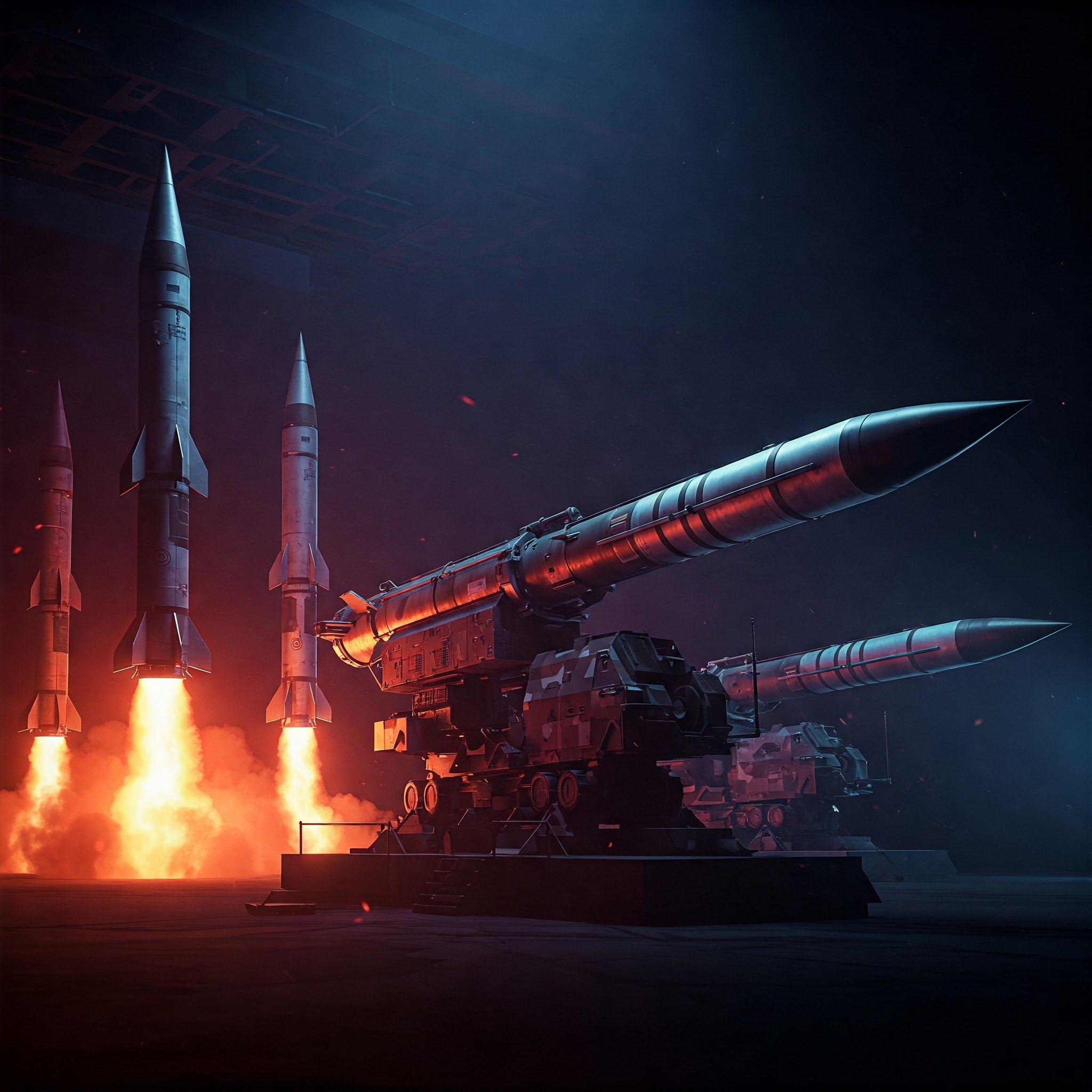Introduction
India, as a rapidly growing global power, has consistently emphasized the development of its defense capabilities to ensure national security and strategic autonomy. Among the various aspects of defense modernization, missile technology has been a cornerstone of India’s military preparedness. Over the past few decades, India has evolved from a missile-importing nation to a missile-developing country with indigenous production and testing capabilities. This progress, backed by institutions like the Defence Research and Development Organisation (DRDO), has allowed India to maintain a credible deterrent while strengthening its regional and global defense posture.
Historical Background of India’s Missile Program
India’s foray into missile technology began in the 1960s, following the establishment of the Indian Space Research Organisation (ISRO) and DRDO. Initially, the focus was on space research and satellite launching, but the dual-use nature of rocket technology paved the way for the development of ballistic missiles.
The Integrated Guided Missile Development Programme (IGMDP), launched in 1983 under the leadership of Dr. A.P.J. Abdul Kalam, marked a significant turning point. The program aimed at developing five types of missile systems:
- Prithvi (Short-Range Surface-to-Surface Missile)
- Agni (Intermediate to Intercontinental Range Ballistic Missile)
- Trishul (Short-Range Surface-to-Air Missile)
- Akash (Medium-Range Surface-to-Air Missile)
- Nag (Anti-Tank Guided Missile)
This initiative laid the foundation of India’s self-reliance in missile technology.
Key Missiles in India’s Arsenal
1. Ballistic Missiles
Ballistic missiles are rocket-propelled weapons that follow a high-arching trajectory and are primarily used for long-range attacks.
Agni Series
- Agni-I: Range of 700–900 km. Designed for short-range, nuclear-capable operations.
- Agni-II: Range of over 2,000 km. Deployed in India’s strategic forces.
- Agni-III: Range of up to 3,500 km with increased payload capacity.
- Agni-IV: Enhanced range (4,000 km), better accuracy and mobility.
- Agni-V: Intercontinental Ballistic Missile (ICBM) with a range exceeding 5,000 km; capable of reaching all parts of China and Europe.
- Agni-VI (Under development): Expected to have a range of 8,000–10,000 km and MIRV (Multiple Independently targetable Reentry Vehicle) capabilities.
Prithvi Series
- Short-range ballistic missiles with tactical applications.
- Prithvi-I: Range of 150 km; used by the Indian Army.
- Prithvi-II: Range of 250–350 km; nuclear-capable.
- Prithvi-III (Dhanush): Ship-launched version for the Navy.
2. Cruise Missiles
Cruise missiles are guided throughout their flight and are designed to deliver precision strikes.
BrahMos
- A supersonic cruise missile developed jointly by India and Russia.
- Range: 300–500 km; speed: Mach 2.8–3.
- Variants: Land-attack, ship-launched, submarine-launched, and air-launched (BrahMos-A).
- India is now working on BrahMos-II (hypersonic version).
Nirbhay
- Subsonic long-range cruise missile.
- Range: Approximately 1,000 km.
- Capable of being launched from multiple platforms and carrying both conventional and nuclear warheads.
3. Surface-to-Air Missiles (SAMs)
These are anti-aircraft missile systems used to defend against aerial threats.
Akash
- Medium-range SAM with a range of 25–40 km.
- Deployed by the Army and Air Force.
- Equipped with a sophisticated radar and command guidance system.
Barak-8 (LR-SAM)
- Jointly developed with Israel.
- Used by the Navy and Air Force to counter aerial threats, including aircraft and missiles.
QRSAM
- Quick Reaction Surface-to-Air Missile designed for mobile platforms.
- Range: 25–30 km.
- Developed for the Indian Army to provide air defense to mechanized formations.
4. Anti-Tank Guided Missiles (ATGMs)
These missiles are used to destroy armored targets like tanks and bunkers.
Nag
- Fire-and-forget ATGM with infrared guidance.
- Deployed on land-based and helicopter platforms (HELINA).
- Variants include MPATGM (Man Portable), SANT (air-launched).
Strategic Defense Systems
Ballistic Missile Defence (BMD) System
India is developing a multi-layered BMD system to intercept incoming missiles.
- Phase I: Targets missiles up to 2,000 km range.
- Phase II: Will intercept missiles up to 5,000 km.
- Components:
- PAD (Prithvi Air Defence) interceptor
- AAD (Advanced Air Defence) interceptor
- Long-Range Tracking Radar (Swordfish)
S-400 Triumf Air Defense System
- Acquired from Russia.
- A highly advanced air defense system with a range of 400 km.
- Capable of tracking and neutralizing multiple aerial threats simultaneously.
- Enhances India’s airspace security, especially against Chinese and Pakistani threats.
Nuclear Doctrine and Delivery Mechanism
India follows a No First Use (NFU) nuclear policy under its official nuclear doctrine released in 2003. The doctrine is based on:
- Credible minimum deterrence.
- Retaliation only in case of nuclear attack.
- Civilian control of nuclear weapons.
- Survivability of nuclear forces through second-strike capability.
India’s nuclear triad is now operational, ensuring nuclear delivery via:
- Land: Agni series.
- Air: Modified aircraft like Mirage-2000 and Su-30MKI.
- Sea: Nuclear-powered submarines like INS Arihant with SLBMs (Submarine-Launched Ballistic Missiles).
Indigenous Production and R&D Ecosystem
India has developed a robust defense R&D ecosystem with DRDO playing a central role.
Key Institutions
- DRDO: Core agency for defense R&D.
- Bharat Dynamics Limited (BDL): Manufactures missiles like Akash and Nag.
- Bharat Electronics Limited (BEL): Provides radar and guidance components.
- Hindustan Aeronautics Limited (HAL): Supports aerial platforms.
India is also promoting private-sector participation under the Make in India and Atmanirbhar Bharat initiatives. Companies like Larsen & Toubro, Tata Advanced Systems, and Kalyani Group are contributing to missile subsystems and launch platforms.
Recent Developments and Modernization
Hypersonic Technology Demonstrator Vehicle (HSTDV)
- DRDO successfully tested the HSTDV, paving the way for future hypersonic cruise missiles capable of speeds over Mach 5.
Agni Prime (Agni-P)
- A new generation ballistic missile.
- Lighter, more agile, and road-mobile with enhanced accuracy.
Project K-5 and K-6
- Under development SLBMs with ranges of 5,000–6,000 km.
- Will further enhance the underwater leg of India’s nuclear triad.
Smart Anti-Airfield Weapon (SAAW)
- A precision-guided glide bomb developed by DRDO.
- Range: 100+ km.
- Used to disable enemy runways and airfields.
Strategic Importance of Missile Technology
1. Regional Deterrence
India faces two nuclear-armed neighbors—Pakistan and China. A credible missile force is essential for deterrence, especially given the volatile geopolitical climate.
2. Strategic Autonomy
Missile self-reliance reduces dependence on foreign suppliers and protects India from sanctions and arms embargoes.
3. Defense Export Potential
With its growing capabilities, India has started exporting missile systems. Akash and BrahMos missiles are being marketed to countries in Southeast Asia, the Middle East, and Africa.
4. Counterforce Capability
India’s long-range precision missiles strengthen its ability to strike high-value enemy targets in a preemptive or retaliatory strike.
Challenges in Missile and Defense Preparedness
1. Technological Gaps
Despite advancements, India still lags behind in some technologies like hypersonic propulsion, MIRVs, and advanced seekers.
2. Budget Constraints
Defense R&D and procurement are capital-intensive. Limited defense budgets often hamper large-scale production and upgradation.
3. Geopolitical Pressures
External pressures, especially from Western countries, can restrict technology transfers or impose sanctions (e.g., post-Pokhran sanctions).
4. Dependence on Imports
Key systems like the S-400 and Rafale jets show that India still relies on foreign nations for cutting-edge technologies.
Way Forward for India’s Missile Development
1. Strengthening R&D
Investments in DRDO labs, AI-driven targeting systems, satellite navigation, and sensor technology are crucial for next-gen missile systems.
2. Private Sector Engagement
Leveraging Indian startups and private firms in missile subsystem manufacturing will accelerate innovation and reduce production costs.
3. Export Expansion
India should aggressively pursue missile exports under the Missile Technology Control Regime (MTCR), of which it became a member in 2016.
4. Integration with Armed Forces
Better synergy between developers and end-users (Army, Navy, Air Force) is required to ensure rapid induction and operational readiness.
5. Development of Space-Based Missile Warning Systems
To pre-empt ballistic threats, India must develop space-based early warning and tracking satellites, like the U.S. and Russia.
Conclusion
India’s journey in missile technology—from the rudimentary rockets of the 1960s to the sophisticated ballistic and cruise missile systems of today—highlights its strategic vision and scientific prowess. Missile technology not only plays a crucial role in military preparedness but also underpins India’s geopolitical standing as a responsible nuclear power. While challenges remain, India’s consistent investments in R&D, indigenization, and strategic partnerships will ensure that its missile arsenal continues to evolve in alignment with future threats and national interests.
Summary Points:
Strategic deterrence against China and Pakistan remains a key objective.
India has developed a range of missiles: ballistic (Agni, Prithvi), cruise (BrahMos, Nirbhay), and anti-tank (Nag).
DRDO, HAL, and BDL are the backbone of India’s missile R&D.
India is strengthening its nuclear triad and BMD systems.
Export potential and technological advancement are future priorities.




